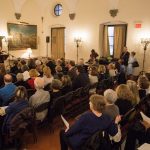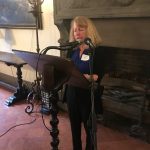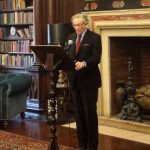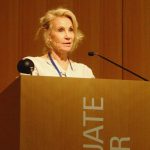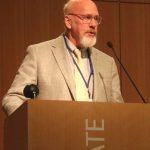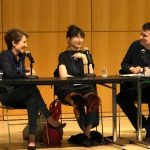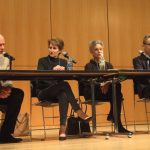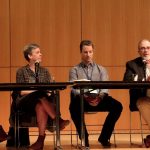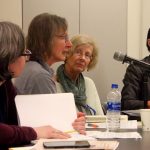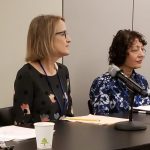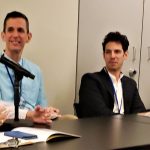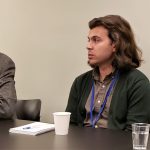⏴ Back to Past Confernces List
Thank you to everyone who attended the 10th Annual BIO Conference in New York!
You can see the program here.
2019 BIO Conference Program
Highlights
- Morning Plenary
- Leading Biographers Discuss Their Craft
The morning plenary opened with introductory remarks from BIO president Cathy Curtis and Kai Bird, Executive Director of the Leon Levy Center for Biography. Then, The New Yorker editor and biographer David Remnick led a discussion with Stacy Schiff and Judith Thurman. Schiff’s books include the Pulitzer Prize-winning Véra (Mrs. Vladimir Nabokov): Portrait of a Marriage and the bestseller Cleopatra: A Life. Thurman, a staff writer at The New Yorker, is the biographer of Collette and Isak Dinesen.Remnick began the session by asking each writer how she was drawn to biography as a genre. Schiff said she doubted any kid sits on a stoop and says, “I want to be a biographer when I grow up.” For her, as she began her career, the appeal of biography was really exploring someone else’s life and writing a book with a very clear beginning, middle, and end. Thurman answered by joking, “I just do what people tell me to do,” then explained that during the mid-1970s she wrote about women writers for Ms. One of her subjects was Dinesen (whose real name was Karen Blixen). By then, Thurman said, “her work had lapsed into obscurity.” The Ms. article led to the Dinesen biography.Thurman said that when she began the work, which took seven years to complete, “I was protected by my complete and total ignorance” of what the project would entail. Thurman described her work in the Royal Library in Copenhagen as continuously chasing down details on Dinesen’s life, finding material out of order, and most of it written in Danish. Then, she had a surprising moment in discovering a telegram that was deeply revealing. “No one had read this telegram [with its] reference to pregnancy and a lost child.” Thurman added that it’s “mostly in letters that [these kinds of discovery] happen,” and that in her experience in writing, “archives are more trustworthy than people” in providing what becomes the more comprehensive picture of the subject.
Schiff shared her experiences tracking down sources for several of her books. For Véra, she found “an enormous cache of material that was wrong” that had been gathered by the Office of Strategic Services, the World War II forerunner of the CIA, on Vladimir Nabokov, saying he was a subversive. With Cleopatra, Schiff said, “a veil of silence” fell over her subject after the murder of Caesar.
When first considering doing a biography of Cleopatra, Schiff said, “I hesitated because I didn’t know how to do it.” But as she proceeded, Schiff began to understand there was a great deal of material available about Alexandrian life and how Cleopatra was educated, for she experienced the classical learning and broad patterns of life shared with Rome and Athens. With that information, Schiff could explore aspects of the queen’s daily life.
Remnick asked the two authors if they prefer their subjects dead, or rephrasing the question, if there are advantages to having a living subject. Schiff, who is working on a biography of Revolutionary War firebrand Samuel Adams, said writing about living persons “is hard for me” and she prefers a “clinical distance, to some extent” from her subjects. For Thurman, “death is the perspective. . . . The idea of writing an unfinished life is very daunting to me.” She noted that she’s turned down books on living subjects, such as a biography of prolific American author Philip Roth, when he was alive. (He died in May 2018.)
As for models in the actual writing of biographies, Schiff said that searching for one “is always important” and mentioned Alan Judd, the British novelist and biographer, among others. Thurman offered Richard Holmes, winner of the 2018 BIO Award, as one model for her.
As to whether there are “definitive biographies,” Thurman said, “no, it’s a semi-colon” rather than a period. “Every generation gets a go at a great figure. . . . Nothing is definitive.” Agreeing with that assessment, Schiff added that she tries not to read other biographers on her subjects, so she can be “coming at these things from the perspective of our time.” In answer to a series of audience questions on the same general topic, she added that she found little value in autobiography. She cited Franklin’s autobiography in examining himself, in that regard, but added he was very perceptive when writing about others.
- Keynote Address
- Morris Recounts the Past and Looks to the Future of BIO
For Saturday’s keynote address, 2019 BIO Award-winner James McGrath Morris said that biographers need to “adapt to changes that were not of our making,” and he urged BIO to create a code of ethics for all biographers. In the era of “fake news” and the ease of accessing biographical information online, biographers need to “build a rampart against the growing hostility to all forms of reporting, be it short form in a newspaper to the long form of biography.” BIO’s establishing a code of ethics, Morris said, “will make clear to readers the high standards to which we hold ourselves.”Morris began his talk by telling the story of BIO’s founding, spurred by a walk he took in the foothills of the Sangre de Cristo Mountains outside Santa Fe, New Mexico. On that stroll, he decided biographers needed their own organization, similar to the ones that existed for romance and mystery writers. He then put out a call in the newsletter he edited, The Biographer’s Craft, for interested biographers to meet and discuss the idea. At that meeting, BIO was born, and the first conference soon followed in 2010. (You can read more of BIO’s origin story in the interview Kitty Kelley conducted with Morris for the May 2019 issue of TBC.)
Morris then spent several minutes acknowledging the BIO members in attendance who took part in the initial planning meeting and the first BIO Conference, and the past and current presidents of BIO’s Board of Directors. In a theme he repeated throughout his talk, Morris said BIO is not a top-down organization, but one that operates from the ground up: “It’s a membership organization dedicated to the success of all its members.” And, he credited Will Swift and Brian Jay Jones for starting the mentoring program and Plutarch Award, respectively. The former gives members a chance to learn from more experienced biographers and the latter has, traditionally, let members choose the best biography of the year. Morris noted that the proposed committee that will select future winners will no doubt do a fine job, but he said he intends to write the board to reconsider the new voting procedure so members can still choose the winner.
In describing the challenges BIO and its members face, Morris said that, given the ubiquity of biographical sources online, biographers need to stress more than ever the art and craft of biography. He called on BIO “to provide instruction and support for storytelling, perhaps by forging a greater alliance with the Mayborn School of Journalism, the nation’s leading center for narrative nonfiction.” He also noted the need to include video and audio “as equal partners in our craft,” and he said BIO needs to find ways to promote greater racial and gender diversity in biographical subjects. The past focus on “leader-centric” subjects led to an abundance of books about famous men, most of them white. Morris would like to see BIO “support and foster works by those whose actions—rather than their fame—merit a biography.”
The last major challenge Morris highlighted was the attack on unauthorized biographies of powerful figures, which he sees as part of the effort by those in power to suppress the public’s right to know what their leaders are doing. The need to combat this and to strengthen the credibility of all biographical works led Morris to his proposal for a code of ethics.
The code, Morris said, should address:- Transparency—the author’s relationship to the subject and any conditions placed on access to source material
- Rights of the subject—an explanation of how a subject can expect to be treated
- Sourcing—clear identification of the sources of material and limited use of anonymous sources
- Obligation—which would include proper attribution of other writers’ material, fact checking, and integrity in reviewing others’ work
Morris concluded by saying that challenges biographers face “are not a cause for glumness.” He said, “When all is said and done, our craft and our love for it will surmount any problem.”
- Prizes Awarded
The winners of the Robert and Ina Caro Fellowship, the Chip Bishop Fellowship, and the Biblio Award were among the attendees who earned special recognition at the opening reception of the 10th Annual BIO Conference on Friday, May 18.
Friday’s events began with nine biographers giving brief readings from their most recent works; you can see a list of the readers and their books here.
BIO president Cathy Curtis kicked off the awards portion of the evening by reading a commendation for former BIO president Will Swift, who left office last year. Next, BIO vice president Deirdre David introduced Heidi Feldman, the winner of the Chip Bishop Fellowship. Feldman received free admission to the BIO Conference and $500 for expenses relating to attending the event. She is working on a biography of Peruvian artist Victoria Santa Cruz. The fellowship honors former BIO member Chip Bishop and supports someone attending the BIO conference for the first time.
BIO board member Justin Spring presented the Biblio Award to Nancy Kuhl, Curator of Poetry for the Yale Collection of American Literature at the Beinecke Library. Given since 2012, the Biblio Award recognizes a librarian or archivist who has made an exceptional contribution to the craft of biography.
Before Robert and Ina Caro recognized the winners of the travel and research fellowship named in their honor, Will Swift introduced the benefactors of this year’s award, Gayfryd Steinberg and Michael Shnayerson. Swift said that Steinberg and Shnayerson, along with he and Deirdre David, are initiating the Boswell Circle, which will feature fundraising events (dinners with a biographer speaking for 20 minutes) to raise money from people who love and support biography. Then, Robert Caro described how the Caro Travel Fellowship is meant to help biographers get a feel for the geographical settings that shaped their subjects. He presented fellowship funds to Amy Reading, and Ina Caro did the same to co-winner Nicholas Boggs. You can read more about the winners’ projects here.
Saturday’s Award
Carla Kaplan presented the Hazel Rowley Prize, which is given to a first-time biographer seeking a publisher. The award went to Barbara Fisher for her proposal for a biography on cultural critic Lionel Trilling. Runners-up were Marti Nodine for her proposal for Resilience: The Life and Work of Artist Dorothy Dehner, and Nicholas Lord for a biography of Gregory Hemingway. Along with Kaplan, this year’s judges for the Hazel Rowley Prize were Dean King and Sarah Kilborne. The prize provides: a $2,000 cash award; a careful reading from at least one established agent; a year’s membership in BIO; and publicity through the BIO website.
Find out more about BIO’s various prizes and fellowships here.
- Telling Life Stories in These Chaotic Times
The title of this panel referred to perceived chaos—or at least change—in publishing, not the world at large. Moderator John A. Farrell and panelists Katherine Flynn, Sarah Burnes, and Tim Duggan explored some of the challenges biographers face to get their work published, but they also offered some encouraging words.
Farrell began by citing sobering statistics from the recent Authors Guild survey about writer’s incomes. The median annual income is just over $6,000, down 42 percent from 10 years ago. Fulltime authors have, on average, incomes below the poverty level. He then asked the panel if this is too gloomy a scenario to offer writers much hope. On the whole, the panelists were fairly upbeat.
Duggan, publisher of a self-titled imprint at Penguin Random House, said he was “pretty optimistic” about his overall view of the market. Despite the rise of analytics, which, in the words of new Penguin Random House CEO Madeline McIntosh, has been fueled by Amazon’s taking personal and political publishing decisions and figuring out “how to boil them down to math problems,” publishers, editors, and agents still react to books on an emotional level. Duggan said, “You’re probably going to sign up a book based on the feeling that you feel when you read the proposal or when you read the manuscript and how it moves you.”
Burnes, an agent, first introduced McIntosh’s observations, then noted that certain sectors of publishing are thriving—ones in which biographies do well. They include audio books and sales at independent bookstores. “It’s always been hard to be a writer,” Burnes said. Writers need to “do [their] work, build [their] community, get [their work] out there.”
Still, the participants didn’t deny that publishers pay attention to one important number—an author’s sales track, or how well their past books have sold. But even then, numbers don’t tell the whole story. Agent Katherine Flynn echoed Duggan’s sentiments, saying “Publishers are still buying on passion.” Duggan said previous soft sales might not matter for a book that’s eight to 10 years old. And Burnes recounted her experience selling a book by an author with a “wobbly” track record but who got a good deal because the publisher loved the book.
Flynn noted that university presses are a good option for biographers, especially for books that take a different angle on the genre. She cited her experience trying to sell a book that was a hybrid of biography and philosophy. Commercial houses were nervous about the approach, but university presses that also sold trade books weren’t. Those presses, she said, “are actually getting a lot smarter, and more creative, and more flexible” about the books they buy.
In assessing what’s popular today, the panelists noted that readers are eager to learn about more “hidden figures,” and Flynn noted that there’s less interest in “great white men” biographies. If writers are tackling the life of a woman or person of color, Flynn said that readers “care about the identity of the writer,” in the sense of their connection to the subject. Duggan suggested that there is less of a need to be writing the “definitive” book on a subject. Biographers also don’t have to shy away from doing subjects who have been done before, even if there is no new material available. Duggan said writers can catch his attention with a sense of style in their proposal or an offbeat angle.
The panelists agreed that crafting a compelling proposal is key to selling a book. Flynn was clear: “A good proposal is everything. It’s how you get a good deal, it’s how you get the right editor who fits your project, it’s how you . . . have a road map to write the book . . . it’s just the foundation of the whole commercial aspect of the project.” Burnes said simply, “Do the work.” Flynn added that for biographies, it’s especially important for writers to note their source material and emphasize if it’s new. Burnes added that writers should detail their access to their subject or their subject’s estate.
At the other end of the publishing process, writers need to play an active role in marketing their work. Even before a book is published, Flynn said, biographers should be accessible to the public and play up their expertise on their topic. But when it comes to using social media, Burnes said not all platforms are right for everyone. “It’s really important to get involved in a way that feels organic to you.” Duggan added, “You don’t have to be on social media at all, if you don’t want to. It’s more important to have other people on social media talking about you than you doing it yourself.”
- Adventures in the Archives
Archivists are operating in a changing world of how material is researched and what is available to writers in a variety of formats. In that context, panelist Mariam Touba asked biographers to “be patient with us.” Touba, a reference librarian for printed collections at the New-York Historical Society, was joined on this panel by 2019 Biblio Award-winner Nancy Kuhl of Yale University’s Beinecke Library and Ellen F. Brown, who co-wrote a biography of Margaret Mitchell and once worked as a rare book and manuscript appraiser/dealer. Moderating the session was Marc Leepson, author most recently of Ballad of the Green Beret: The Life and Wars of Staff Sergeant Barry Sadler from the Vietnam War and Pop Stardom to Murder and an Unsolved, Violent Death.
Along with advising patience, Touba had this tip for researchers: Calling or emailing in advance of a visit, particularly if you’re traveling from a distance, is helpful and time saving for all concerned. She said it is good to understand that librarians and archivists, like herself, want to work with genealogists, architects, other researchers, writers, and not put them off. In that regard, “we’re constantly exploring newer ways to help researchers” find what they are looking for.
But for a researcher, the way libraries and archives work can be confusing, as they’re anything but uniform. Brown said, “I feel like rules are always changed.” Brown, who is currently working on a book about literary estates, added, “don’t let [the process] intimidate you.”
At the forefront of change in research is digitization. Touba, who specializes in newspapers of the Revolutionary War and Early Republic eras, said, “The good news is that it’s so rapid.” And there’s more coming. “Finding aids will be similarly available for newspapers and periodicals” that are digitized, as many are for printed and manuscript collections. Touba added that state libraries and newspaper publishers often offer digitized collections that many researchers don’t realize exist. Commercial services offering digital newspaper and periodical collections also are available (including newspapers.com), which are available by subscription. She also noted the large number of books that have been digitized and made available online through HathiTrust, Google Books (which is particularly strong for searching footnotes and endnotes and for research tips, as several panelists and audience members mentioned), and other sources like ProQuest and university-digitized theses and dissertations.
Kuhl conceded that “some of the ways we digitize things [in libraries and archives] can be obscuring” and checking with the library or archives beforehand can ease a researcher’s task in trying to isolate what he or she is searching for.
Researchers can also take advantage of technology in their onsite work, where permitted. Brown recommended Scanner Pro, an app for smart phones to make a PDF image, and Adobe Pro to word search the scanned document. Apps like these save time in the library or archive and cut down on the expense of having to pay for extended stays to use institutions with limited public hours, the panelists agreed.
“Mostly, we believe [digitizing technology on smart phones] is helpful” for the researcher and is allowed at Beinecke, Kuhl said.
While printed materials are usually easily decipherable, handwritten materials remain tricky, made even more complicated by archaic spellings and lettering—such as today’s letter “f” being the 18th century’s “s”—and word usage. Kuhl suggested “triangulation” to figure out the word—either with a “more eyes are better” approach or figuring out what the words surrounding it are. “You have to devise a system and work from there.” Brown suggested reading a document out loud to help make the meaning clearer. She also said the Library of Virginia website offers some suggestions for deciphering handwriting.
Later in the session, one of the follow-up questions was about how to begin research on a subject The answers included: checking World Cat, a global catalog of library books; searching ProQuest for journals, databases, and books; and going to Ancestry.com for census and other materials. In answering a question about Wikipedia, Brown said that its articles’ endnotes were its greatest value—and Touba and Kuhl agreed that it was a great starting point for resources on a subject.
After all is said and done about researching, control of the material being examined and its use “is very complex,” Kuhl said. “We’re not authorities” when it comes down to what can be published from the collection, nor arbiters of fair use. Touba said the issue of what you’re allowed to see and what you are allowed to publish can be two different matters. Kuhl added, “It finally is the researcher’s responsibility” and not the library or archive to determine who, if anyone, holds the copyright to the material in any form, from print to image to sound.
When a similar question arose over the definition of fair use in copyrighted material, Brown, who is also an attorney, said there is no hard-and-fast rule on the number of words or any other guide as to what constitutes fair use. She suggested one safe way around the question is paraphrasing. “Trust yourself” in that regard, she said.
—John Grady
- Fire Up Your Narrative
Moderator Linda Leavell recruited a panel of prizewinning biographers to share some of their tips for writing gripping narrative. A Plutarch Prize winner herself, for her biography of Marianne Moore, Leavell figured that writing that catches the attention of book juries “will also get the attention of an agent or a publisher or a reviewer or, of course most importantly, readers.”
Leavell started by asking the panelists if they found something particularly gratifying in the reviews of their books. For Caroline Fraser, winner of the Pulitzer Prize and BIO’s Plutarch Award for Prairie Fires: The American Dreams of Laura Ingalls Wilder, she was gratified that people responded to the historical context she presented. She approached her book as a historical biography, which was a stretch for her, since she was most familiar with literary biographies. Tom Reiss, whose The Black Count: Glory, Revolution, Betrayal, and the Real Count of Monte Cristo won the 2013 Pulitzer Prize, also approaches his subjects through a larger historical lens. He is gratified when readers get a new perspective on a topic they thought they knew well, such as the French Revolution. His goal is to write about history through the individual lives he chooses as his subjects.
John A. Farrell knew he was writing about a polarizing figure when he chose Richard Nixon as a subject. He pursued what he called “ruthless objectivity” as he searched for the human story underpinning the president’s well-documented political career. Farrell said he wanted to be empathetic “without excusing him.” He was gratified that reviewers seemed to recognize and respond to this approach, and he was grateful for the good reviews he got from presidential scholars, since his background is in journalism. The book’s honors include the New-York Historical Society’s Barbara and David Zalaznick Book Prize.
When Ruth Franklin chose to write about author Shirley Jackson, she saw the book as a “literary reclamation” of the author. The biography went on to win the Plutarch Award. Franklin wanted readers to know about Jackson’s work beyond “The Lottery,” to think of her as more than a genre writer, and to try to place Jackson as an important figure in the mid-20th-century literary canon. Franklin said, “It was really gratifying to me that so many readers did respond to the book on that level.” She also appreciated it when readers said they went back to Jackson’s work, rereading some of it or reading other pieces for the first time.
Getting to the nuts and bolts of the panel’s topic, Leavell asked the writers for one piece of advice for firing up a narrative. Farrell’s was succinct: “Don’t be afraid to skip over the boring parts.” Even a 700-page biography doesn’t need to include boring details, he said. Instead use that space to explore how the subject felt about important moments in their lives. Franklin’s advice was, “Look for the dramatic scenes wherever you can find them.” Reiss said authors should not be too explicit about putting themselves in the narrative—though in his books, Reiss usually makes an appearance. For him, the key is introducing his “mission” as a biographer in “an elegant way”—often a scene that explains how he got some information. “It’s a nice device for revealing why you’re pumped up about [the subject], and I think that makes the reader more pumped, too, if it’s done subtly.” For her one tip, Fraser said biographers should look for places where they can add tension or suspense to the story. With her Wilder book, Fraser worried that this approach might be a bit hokey or novelized, but it seemed to fit the material and “ultimately, it did create a better reading experience.”
The four authors also talked a bit about their revision process. Franklin said she didn’t have to cut when she turned in her manuscript, but she had already received some tough love from her editor earlier in the process. One note Franklin received: there was not enough of her voice in the book. Taking time from writing and immersing herself again in research gave Franklin the space to add more of herself in the book.
Farrell said part of his revision process for Richard Nixon: The Life included sending the manuscript to Nixon experts. He felt at times with his previous books his writing style was flat, and he needed to enliven his style to deal with a personality as large as Nixon’s. Farrell wanted the experts to help him identify clichés and point out where he could add more detail to certain scenes.
Reiss said that thinking about his ideal reader helps guide his revisions. That reader is someone who’s not a history buff or biography fan. “I’m going for an effect that reaches people outside of this building.” He’s not going to dumb down the history, but Reiss figures if he can reach those readers, his books will also resonate with history buffs.
With her Wilder biography, Fraser got some good news/bad news from her editor after turning in her first draft. The editor told her, “I think the middle is just fine.” Which meant Fraser needed to really work on the beginning and ending. Part of that included “pulling back from the level of detail I thought was necessary.” She resisted that cutting at first, but when she saw the revised copy without the extraneous material, she realized the book was better. Fraser also noted that printing out her manuscript made revising it easier, rather than merely reading and revising on a screen. On the page, it was easier for her to note repetitions and clichés.
- Funding Primary and Archival Research
When beginning a biography, and discovering that an archive with needed material was in private hands and not close by, panel moderator Justin Spring explained that he had “financial problems putting the book proposal together.” To address the financial hardship, he sought small grants from libraries, and larger fellowships such as the one given by the Leon Levy Center for Biography at the City University of New York.
Picking up on the idea of short-term grants, Norman Hirschy, a senior editor at Oxford University Press, said the press has such grants but, somewhat surprisingly, they “don’t have enough people applying for them.” He added, “Don’t be shy about asking questions” about grants from presses. “But be really nice,” he said, which drew laughs from the audience. Hirschy stressed, “Where there’s a will, there’s a way” in covering expenses to research and write, so seek out and take advantage of what’s available. And, even with small, short-term grants, “if you plan your research well, you can get a lot done.”
Spring offered this tip for applying for grants: “You have to do pump-priming”—spending some money out of your own pocket to better understand the subject before applying for a grant. The grant applications become a way of “shaping your project.” Spring also said researchers can economize by “piggybacking,” such as using a business trip to also go to an archive for research.
Stephen Heyman has experience landing one of the big biography fellowships. He is currently a fellow at the Levy Center, working on a biography of author and conservationist Louis Bromfield. Heyman said, “The whole thing had me kind of blindly struggling to find” what the subject is and where and how to begin the research without a huge investment of time and money.
When it came to writing a proposal for a biography on Bromfield, now largely forgotten, Heyman said he wrestled with the thought, “Maybe it’s a terrible idea.” And so he set about “doing the least amount of archival research as possible.”
In Heyman’s case, this meant a trip to Ohio State University in Columbus, where he discovered “a huge amount of stuff” in a collection of unpublished letters and realized how valuable this was. He then did a survey of the university’s collection of materials on the Pulitzer Prize-winning novelist.
One way to cover writing and research expenses after selling a book, at least for one year, comes through the National Endowment for the Humanities Public Scholar Program. The awards in this program can reach $60,000 and are not need-based. Geoff Burrows, a senior NEH program officer, said the program itself is designed to help those writing books for a general, not scholarly, audience, and the money may be used for researching and/or writing in the humanities. “Even if it’s research funding at the writing stage, we want a sample of what you’re going to do” to reach a public audience, Burrows explained. And, he added, “We [also] want to know what research you’ve done” in the application process. This year, applications are available in November and the deadline for filing is February 5, 2020.
A panel reviews the applications for biographies, Burrows said. He admitted that “it is often difficult to find reviewers” in biography, in part because the positions turn over annually. The pay is also minimal—$250. Burrows said, “We also [can] put biography [proposals] on the subject matter panels,” so it has another chance for funding. In answer to a question, Burrows said, “We give the entire peer review comments” back to the applicant. He added that the comments from the three reviews “are sometimes contradictory,” but that shouldn’t discourage biographers from applying. “The key to winning is re-applying” Burrows said, and learning by doing. The NEH has examples of successful applications on its website.
Burrows also addressed the reference letters applicants must submit. The ideal reference “knows your project’s importance and . . . speak[s] for you” because that “can push a project over the line” for funding. On the general topic of references, Spring said biographers should send their book proposals to the people they contact for references, because they can add valuable insights to the proposals before submission.
—John Grady
- Balancing an Artist’s Life and Work
Moderator Karin Roffman and panelist Carol Sklenicka have written about authors; Patricia Albers has studied the lives and work of visual artists; and Mark Dery’s biography examined a subject who straddled both worlds, but whose greatest creation may have been his own persona. Together, Roffman and her panel addressed some of the issues authors should consider when writing the life story of an artist.
Albers began by saying that biographers of artists of all stripes are “looking at how creativity operates . . . through the lens of our particular subject.” Then the biographer tries to discern what produces the creative impulse: “Does it come out of hardships, does it come out of psychological turmoil . . . or does the person need to achieve a certain level of wellbeing in order to become a fully creative human being?” As biographers of artists, Albers said, “we are singularly positioned to understand and engage with the autobiographical and psychologically meaningful aspects of the work. . . . We know these people’s lives in and out, we’ve done these deep dives into the cultures in which they operate.” Biographers of artists ask different questions than most academics or journalists would, based on their knowledge of both the artist’s life and work.
Albers offered an example using a photo by her current subject, the Hungarian photographer Andre Kertesz. The artistically composed picture of a tulip was much more than a picture of a flower. He took it while working for House and Garden, and he hated working for the magazine, which each month offered “dull” photographs of flowers. To Albers, Kertesz’s photo was a “sly rebuke to House and Garden.”
For her part, Sklenicka took slight issue with the panel topic, saying she didn’t see an artist’s life and work as separate. Sklenicka has written about Raymond Carver and is currently writing a biography of the author Alice Adams. When choosing an author as a subject, Sklenicka said the biographer has to decide, “Are you writing a critical biography or are you writing literary criticism under some other guise?” But Sklenicka said she doubted one could “possibly care about a writer without loving their work, and you can’t care about their work, in most cases, without being curious about their lives.” The biographer’s job is to conflate and intertwine those two strands—“you aren’t separating and balancing them.”
Answering a question about the process of intertwining the subject’s life and work, Sklenicka said that nailing down the chronology of when a piece is created and how it fits into the facts of the life is key. It’s also one reason that writing a book about an artist can take so long to write, because the biographer doesn’t necessarily know that chronology when starting the book, and so must constantly revise. “It seems so banal, putting things in the right order, but it will teach you a lot.”
For his biography of author and illustrator Edward Gorey, Dery constructed a timeline of dates, which he compared to “stringing the beads along a thread.” That gave him a framework to do the “exegesis” of Gorey’s work. And in his approach, Dery looked beyond manuscripts and illustrations as “texts” to be read and explained. He saw even Gorey’s choice of clothing as a text, which Dery interpreted as Gorey’s comment on the mix of highbrow and lowbrow in culture. As far as reading Gorey’s actual texts, Dery said, “You can use the life as a prism to refract the work.” And the opposite holds true as well.
Asked if biographers should bring in the “times” to augment an understanding of the artist’s life and work, Sklenicka said that approach can be clunky, if an artist didn’t explicitly refer to current events or if they didn’t shape the work. Albers, though, said that in her books, her subjects’ reactions to external events are crucial, as it can illuminate the subjects “as human beings and as artists.”
The subject of the academic response to biography—from apathetic to hostile—drew a strong response from Dery. He said he had no concern for academics who smear biography, and he called biography the genre of our moment, given that so many people document their own lives on social media. He also said biography can achieve excellence in brevity, citing Edmund White’s work on Proust for the Penguin Lives series.
- The Study of Biography Today
When he set out years ago to establish a field of study in biography, moderator Nigel Hamilton said he “had no idea of my ignorance” in how to successfully root that field in today’s academic environment. The United Kingdom at the time “was woefully behind other countries in this regard.” And even now, teaching biography in universities is still hit and miss.
Hamilton is the author of a three-volume biography of Franklin Delano Roosevelt during World War II, among other books. He said that where he fell down panelist Hans Renders, his co-author of The ABC of Modern Biography, succeeded. Renders heads the Biography Institute at Groningen University in the Netherlands. But getting the school interested in biography as an academic topic wasn’t easy. Renders put it bluntly, “I bring this [idea of teaching biography] to the history department; they need something to spit on.”
As to how he became interested in biography, Renders said, “I used to work as a journalist writing stock obits.” What became important to him in that work and carried through into pursuing biography was recognizing “there must be a turning point in a public life” and building from there.
Linda Leavell said that although she holds a doctorate in English Literature, she “actually went to biography school” to help her begin her work.
But it was “school” in a different way.
Leavell is the author of Holding on Upside Down: The Life and Work of Marianne Moore. What brought her to write about Moore was hearing that there needed to be a new biography of the poet, but the prospect “seemed very daunting.” Leavell said she dreaded looking for an agent but eventually the agent “taught me all I didn’t know.” And she agreed about the academic disdain for biography. She said English departments are ignorant that “biography is a work of imagination.” The departments do not recognize that it “could be an art form as much as a sonnet.” The key to achieving this is to “be true to the facts and integrate them in many different ways.”
Billy Tooma, who also holds a doctorate, said, “We swept biography under the rug” as part of the basic curriculum and a way to instruct students. Tooma, who teaches at the college level and is a filmmaker specializing in biographical documentaries, said that the overlooking of biography in elementary and high schools is tied to the demands of the 180-day academic year and ignoring the reality that students “can learn through biography.”
Tooma said his interest in the form came from reading a biography of J. R. R. Tolkein as a middle schooler, and it has carried through into his career. He realized that biography doesn’t have to be told only through books, and today his students at Essex Community College in New Jersey “get it” when it comes to visual biography. It’s something that interests them, and they want to experiment with and learn researching, storytelling, and some video craft from the experience.
But biography in book form certainly has its place in the classroom for Tooma and the other panelists. Both Tooma and Leavell agreed that using biography should be part of a larger effort to teach students how to read nonfiction as a matter of cultural literacy. Renders said, “You need a good story especially. Students are attracted by good stories.” Tooma said, “Biography humanizes the sciences, that’s something other genres can’t do.”
Leavell noted, “like other genres, biography has evolved” in the late 20th and into the 21st century. “Our expectations of biography have changed.” For example, the concept of “genius” is “an idea that has become very unfashionable” in describing a subject. “Now we see the political, social, and economic circumstances” surrounding that person. Biographers are also now focusing on different things, she said. “Gender makes a difference,” and so does class.
Renders had this tip for teachers looking to use biography in the classroom: “With students, try to get them to understand . . . that reading biography is fun.” He suggested having them “read two biographies of the same person” to see the different approaches to a single subject.
—John Grady
- Promoting Your Biography
The experts for this session on how to effectively promote a book were Dan Blank, founder of WeGrowMedia; Declan Taintor, publicity manager at Henry Holt; and biographer Melinda Ponder, who shared some of her experiences promoting her Katharine Lee Bates: From Sea to Shining Sea.
Moderator Ruth Franklin began the session by asking the panelists what the single most important thing an author should do six months before their book’s publication date. Taintor said he would want the author to develop a certain mentality, rather than taking a concrete step. Authors should realize that “people don’t care about you or your book.” The writer’s enthusiasm for and immersion in the subject doesn’t move the general public. So, the marketing effort should strive to convey some of that excitement to potential readers.
Ponder pointed out several of the things she did before her book was published. She recommended that authors attend conferences—the BIO Conference in particular—and join writers’ groups to get support and ideas. Ponder also put together different slideshows about her subject that she could present to different groups, with each presentation having a slightly different angle on the subject’s life and work. Ponder also turned to others for help, both friends and relatives who could talk up the book, and professionals such as a web designer and a publicist.
Blank’s suggestion was to build a spreadsheet of names, beginning a year before, to start building relationships with people. Start with everyone the writer knows, from former classmates to members of organizations the writer belongs to. Then the author can tailor emails to solicit support for spreading the word about the book. Another tab in the spreadsheet is for people or organizations who care about or have some connection to the subject. As Blank brainstorms names with authors, they try to come up with a persona for the “ideal reader” of the book—what do they read, what podcasts do they listen to, what events do they attend. Then Blank might create a podcast tab in the spreadsheet, with potential podcasters to reach out to. Another tab might focus on literary festivals. The goal is to identity an individual, make contact, and build a connection.
The conversation then turned to social media and the idea of an “author platform.” Ponder said she used her academic background teaching literature to build her platform, but she let her publicist handle postings to social media. Taintor said that the Big Five publishing houses spend a lot of time focusing on author platforms, but he said being on social media sites like Twitter and Facebook is not essential. “If you’re already good at [using social media], great . . . if you’re not already good at it, you’re not going to get better at it by the time your book comes out.” He said if an author starts with fewer than 200 followers, “give up.” Taintor also admitted that the Big Five might sign someone who isn’t a good author if they already have 200,000 Twitter followers.
Blank defined the author platform as going beyond social media: It’s the writer’s ability to communicate, “knowing how to talk about your book in a human way, in an interesting way, and building trust.” To Blank, social media’s role is to give an author access and opportunity for making connections. It doesn’t sell books per se.
When developing a publicity campaign, Taintor said writers shouldn’t treat “the media” as a monolith, or to focus exclusively on the mainstream media. He talked about finding the “buckets” of appropriate media, using Franklin’s biography of Shirley Jackson as an example. For that book, he would have targeted outlets that focus on literature, ones related to the horror genre, feminist outlets, and media based in New England or that focus on New England subjects. He said, “It’s one book but you’re telling several different stories to several different outlets about what the book is about.” But when approaching an outlet in a particular bucket, authors shouldn’t beg or harangue. A better method is to realize media outlets need content and pitch the book with a “have I got a story for you” angle.
As far as targeting different potential audiences, Ponder did something similar as she looked for venues for her presentations. She targeted groups, for example, that had ties to Wellesley College—her subject’s alma mater—or tied her talks to anniversaries of historical events that were relevant to the book.
Blank said that authors should play “the long game” and focus less on trying to boost the first month’s sales and more on reaching out to new readers and influencers over time. That can include looking for how the book ties in to the topics people are talking about, and it usually relies to some degree on word-of-mouth buzz. Seeking to build those connections can help not only an author’s current book but future ones as well. When Franklin noted that building one-to-one connections can be time consuming, Blank said he saw it as part of being a professional. “You’re participating in the business of publishing. It’s an ongoing commitment.”
When asked what is the biggest waste of time or marketing mistake, Blank said it’s waiting too long to start thinking about publicity. Even two years before a pub date is not too soon to start building the connections he sees as essential to the process. Taintor responded that authors sometimes are reluctant to reach out to their agents, and that’s a mistake. They should turn to their agents when problems arise and count on them to yell at publishers, when necessary. Taintor said an agent should be a writer’s “closest friend and ally.” It’s “you and your agent against the world.”
- Fact and Speculation
Gretchen Holbrook Gerzina said when she began working on her first two biographies she had “too much material.” But when she approached her work on former slave Lucy Terry Prince, who lived in the 18th century and was the first African American poet, “there was nothing.”
To fill in the gaps, Gerzina said she went down a road “to find historical context” and “try to piece it together.” At Historic Deerfield, Massachusetts, she found some of that historical context and used it in her Mr. and Mrs. Prince: How an Extraordinary Eighteenth-Century Family Moved Out of Slavery and into Legend. The pieces included a one-page letter on her subject’s medical condition and birth records of the Princes’ children. The discoveries were sometimes “serendipitous,” she said.
Gerzina turned to two people for assistance in the research. Her husband, who had been recently laid off, had the time to help and discovered “notes on the back of a ledger book” that were important for developing the book. The other helper was her mother, from whom Gerzina learned that she, Gerzina, was descended from the white family that had owned Lucy Terry Prince’s husband. And because of the dearth of material, Gerzina took the tack of incorporating her own search for information into the story. When there’s a shortage of archival material, she said, “you need something besides the straightforward chronology of what you’ve discovered to drive the book forward.”
Michael Hainey, author of the memoir After Visiting Friends: A Son’s Story, said his book was filled with facts yet also “fueled by speculation,” as he tried to learn more about his father. In the end, he used his experience as a journalist to detail “meticulous reported scenes” as he also let readers experience what he did as he searched for the facts. Hainey said he was “not just telling a life but taking [readers] to a place.” He compared the experience to watching the film Pulp Fiction whose viewers might say, “I don’t know where this is going, but I’m going to stay with it.” And along with the factual scenes, Hainey said he added “poetic conjecture” about his father’s life. He said biographers should give themselves permission to try different approaches and cited Edmund Morris’s Dutch, the controversial book about Ronald Reagan, as an example.
Stacy Schiff, author of Cleopatra: A Life and other biographies, said in her research she “asks why something is unavailable or why something is missing or why something has been suppressed.” And the answers, she said, can be “very fertile.” In the case of her book on the Salem witch trials, she said, “1692 just didn’t exist in Massachusetts” given the purging of information on the trials from public records and personal papers. That purging reflected the community’s shame over what had transpired.
In the case of Cleopatra, contemporary records on her subject’s life were “thin if not scant,” which led her to go “where the material took me.” At times, that led to speculation based on historical context provided by known facts on similar events. Schiff’s example was Cleopatra’s trip down the Nile with Julius Caesar. It was first described in documents more than 100 years after the event supposedly took place. Did it really happen? Schiff argued it likely did, as it was known from other sources that foreign dignitaries made similar trips. And with details recorded about those trips, she could flesh out the historic river cruise with the queen and the Roman general. Schiff also reminded her readers about who provided many of the sources about Cleopatra: Roman historians who were writing well after the fact and who wanted to present a certain view. The Roman writers were anti-Cleopatra, yet they had an incentive to make her larger than life: to make Octavian/Augustus Caesar’s victory over her more significant.
Moderator James McGrath Morris brought up the question of how to handle conflicting accounts about a part of a subject’s life. His approach, he said, was to argue like a prosecutor for the account he found most convincing, then offer the alternate view in the endnotes. Schiff said that with Cleopatra two accounts of her death survive. Rather than favoring one over the other, she included both, so “ultimately, she dies twice in the book.” Describing a slightly different situation, Gerzina faced pressure from a subject’s family to not say the subject was mostly likely a lesbian. But she could include details that suggested it. “You put it all out there,” Gerzina said, “and then you let the readers draw their own conclusions.”
As far as hoping to uncover one absolute truth, Hainey said writers need to let go of the idea that they’ll find it. By obsessing over what’s missing, a writer might “not see what’s present and in what’s present, what’s possible.” Since biographers aren’t going to find every fact or answer every question, they should embrace that, as a gap can be a strength. Address the gap in the book, he said. “The reader will not only forgive you,” said Hainey, they’ll perhaps thank you for bringing them into the process. Hainey also thinks it’s acceptable to break the fourth wall and engage the reader directly when assessing evidence.
When there is no new material on a subject, Schiff said the author’s voice and how they tell the story becomes a key part of the book. “There was nothing about Cleopatra that wasn’t known for hundreds of years. . . . I just put it together in a way that no one else had done before.” Echoing Hainey, she said biographers can “underestimate how much the absences can be worth and overestimate the serendipitous finds.”
Asked how biographers should handle gossip about a subject, Schiff joked that biography is “just gossip with footnotes.” Morris said that biographers need to assess who said the gossip and how it was used. And Schiff noted that how your subject was perceived by others is “absolutely critical,” so gossip can be extremely useful.
In the end, Hainey said, “You are the gatekeepers of what you feel earns its way on to the page . . . the reader is going to trust you.” Gerzina agreed, saying that while crafting a great story is important, biographers need to show that they’ve done the work and readers trust it. The readers need to feel that a writer tells “to the best of her ability, what actually was going on.”
With reporting from John Grady
- Video: Morning Plenary
Watch the plenary featuring David Remnick, Stacy Schiff, and Judith Thurman.
- Video: Keynote Address by James McGrath Morris
Watch the keynote address given by 2019 BIO Award winner James McGrath Morris.
Photos
- Friday night readings
- Julie Dobrow at the Friday night reading
- Robert Caro introducing the winners of the Caro Research/Travel Fellowship
- Barbara Fisher, winner of the 2019 Rowley Prize
- 2019 BIO Award winner James McGrath Morris
- 2019 Plutarch Award winner David W. Blight
- Morning Plenary
- Fact and Speculation panel
- Telling Life Stories in These Chaotic Times panel
- Balancing an Artist's Life and Work panel
- Adventures in the Archives panel
- Funding Research panel
- The Study of Biography Today panel
All photos by Michael Burgan except for Julie Dobrow (Lisa Napoli), the morning plenary (Brian Jay Jones) and the last three panels (John Grady).
